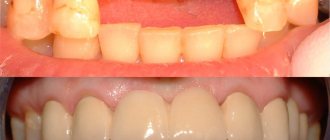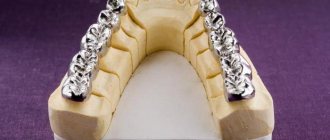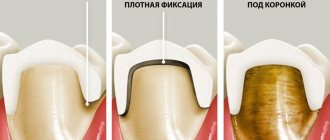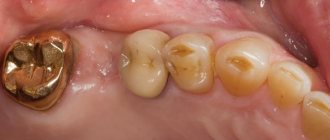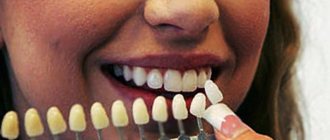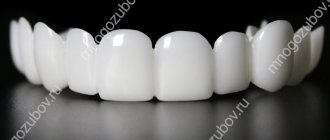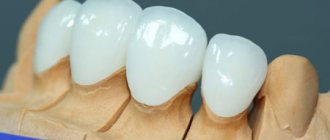Today, dentists have a lot of options for prosthetics - restoring a damaged or missing tooth. One of the most effective solutions is metal ceramics - it is reliable and aesthetic. With its help, you can restore one or more teeth, and the structure is supported by implants or the patient’s own teeth.
Metal-ceramics are orthopedic structures - crowns and bridges, which are made by spraying or casting ceramics onto a metal base or frame. This method of prosthetics is in great demand, since the material used to restore the shape and function of the tooth does not cause allergic reactions. Metal-ceramic prosthetics are more often performed for the masticatory region, since in this case the strength of the structure is a priority, but this does not at all deprive artificial teeth of their aesthetics. Such designs closely replicate the structure and color of natural teeth.
Structure and types
Metal-ceramic dental prosthetics got its name due to the structure of the structures: inside it has a cast metal frame with a thickness of 0.3-0.5 mm. The material of manufacture is cobalt or nickel-chromium alloys. In some cases, alloys of precious metals - platinum or gold, palladium and others in different proportions - can be used. Crowns are divided into corresponding types according to this parameter.
The use of gold has an undeniable advantage - due to the natural yellowness of the precious metal, it is possible to achieve a natural shade of the structure, which is especially in demand when it is necessary to replace the front teeth.
The metal frame is covered with ceramics. The base is veneered using manual layer-by-layer application of ceramic mass. The structure is fired in a kiln after each layer is applied - this allows for the best connection between metal and ceramics.
As for the structure of the structure, the following types of metal-ceramics in dental prosthetics are distinguished:
- Actually single crowns. They are widely used to restore teeth in the lateral zone when they are more than ⅔ destroyed.
- Bridges. They are designed to restore several missing teeth in a row. The most reliable design is considered to be two crowns for supporting teeth and 2 artificial teeth between them.
E.max ceramic dental bridge –
If you are planning prosthetics on your front teeth, then a dental bridge made from IPS E.max ceramics is the best option in terms of aesthetics (even compared to bridges made from Multi-layer zirconium dioxide).
The “Emax” material refers to glass ceramics, because this material consists of 70% lithium disilicate crystals. Due to the fact that the E.max glass matrix is as similar in structure and transparency as possible to natural tooth enamel, crowns, veneers and bridges made from this material can be made completely invisible against the background of neighboring teeth. Clinical case No. 1 – before and after photos
Clinical case No. 2 – before and after photos
Advertising
E.max glass ceramics is practically the only material that allows achieving good aesthetics in patients with a high level of transparency of tooth enamel (if the transparency coefficient is low, then good aesthetics can be achieved with zirconium dioxide). E.max crowns require less grinding of the supporting teeth, which increases their service life. And besides, the use of this material practically eliminates the occurrence of ceramic chips.
Important points - E.max ceramics are available in several versions, but for the manufacture of bridges it is best to use “IPS E.max PRESS”. Bridges are made from this material by pressing under conditions of very high temperature and pressure, making the finished structure very strong (about 400 MPa). However, there are several limitations for E.max bridges...
Firstly, you can make bridges from E.max with a length of no more than 3 units, i.e. They can only restore a single missing tooth. Secondly, their safety margin is sufficient to restore mainly only the anterior group of teeth (the distant abutment tooth should be no further than the 5th tooth inclusive). Therefore, if you need to restore the chewing group of teeth, then a priori the choice falls on bridges made of zirconium dioxide or metal ceramics.
Conclusion: The E.max glass-ceramic bridge is the best option if you require a 3-unit bridge in the anterior area and if you have the highest esthetic requirements. Considering that 1 crown made of E.max PRESS material will cost in Moscow in 2021 - from 26,000 rubles, then the cost of a bridge of 3 units will already be about 72,000 rubles. In the regions, the price for 1 unit may be slightly less (from 20,000 rubles). And don’t be confused by the fact that E.max is cheaper than bridges made of zirconium dioxide - it’s just that very expensive equipment is used in the manufacture of the latter, which affects the cost.
Advantages and disadvantages of metal ceramics
Compliance with manufacturing standards and installation technology almost completely eliminates possible harm from installing the structure. The use of modern materials eliminates the release of toxic substances, but it is important to remember that an individual reaction may occur.
The ceramics itself, used in the manufacture of artificial teeth, does not cause allergies - a possible reaction is provoked by the metals in the frame of the structure. For example, chromium-nickel alloys can provoke an allergic reaction to nickel, and the use of base metals under the influence of saliva can be susceptible to oxidation reactions. Symptoms of an allergic reaction may include:
- burning in the mouth;
- metallic taste;
- swelling of the gums in the area of contact of soft tissues with the crown.
If such symptoms occur, it is important to consult a dentist - you will probably need to replace the structure with an all-ceramic crown or use another prosthetic method.
Other disadvantages include the possibility of exposing the metal frame in the event of receding gums. It is worth noting that structures made of zirconium dioxide are not subject to this phenomenon. In addition, the technology of metal-ceramic dental prosthetics involves grinding the tooth under a crown and removing the pulp in many cases, which is also a disadvantage.
The advantages of metal ceramics include high strength and long service life. Today, metal-ceramics are used for both single crowns and bridges - it is in demand when it is necessary to replace teeth with a significant chewing load. The frame made of aluminum dioxide or zirconium is strong enough, so the dentures can withstand heavy loads.
A long service life - 10-12 years for alloys of base metals and about 15 in the case of using a gold-platinum alloy - is a key advantage of the designs. This is only relevant for those prostheses that are made using individual casts. It is also important to follow the doctor’s recommendations for care - in this case, the prosthesis will last as long as it should. This is necessary because one of the common reasons for premature crown removal is the development of secondary caries at the junction of natural and artificial tissues, so it is very important to visit a doctor in a timely manner.
To summarize, we can say that the advantages of metal ceramics are as follows:
- comfort of wearing structures;
- functionality - function is restored due to the flawless modeling of masticatory hillocks;
- strength;
- long service life;
- acceptable aesthetics;
- biological compatibility - in the absence of allergic reactions to metals;
- the possibility of prosthetics for both anterior and chewing teeth;
- shade fastness - ceramics are not susceptible to the action of dyes;
- comparative cheapness;
- the possibility of restoring the structure without removing it in the event of minor chips.
Installing a crown on a tooth
A dental crown is installed on one tooth in several stages.
- Diagnostics.
To find out whether it is possible to put a crown on a tooth, the doctor examines the oral cavity visually and necessarily sends it for an x-ray.
- Treatment.
Then the necessary treatment is carried out. Most likely, you will have to remove the nerve under the crown and fill the canals.
- Grinding of teeth for crowns.
If the dental tissue is slightly damaged, then the remaining walls are ground down. In the case where the “top” of the tooth is completely missing, a dental inlay is additionally installed under the crown, which will ensure its reliable fixation. Previously, instead of an inlay, a pin was installed; today, a dental crown on a pin is considered an outdated technique, which has a number of complications leading to tooth loss.
- Making dental crowns.
After all the preparatory procedures have been completed, impressions are taken from the patient and sent to a dental laboratory.
- Installation of dental crowns.
This is followed by fitting of the finished product in the oral cavity and installation. Many people are concerned with the question “What are dental crowns glued to?” Orthopedic structures are placed on special cement, which allows the prosthesis to stay in place for a long time and reliably.
All manipulations are carried out over several visits. Making dental crowns is possible in a few hours, provided the necessary equipment is available in dentistry.
Crown on a living tooth without pulp removal
If we are talking about grinding healthy teeth to fix a dental bridge, then an important question arises about the need to depulp the tooth. Everything here is very individual. But, as a rule, doctors prefer not to take risks and in most cases remove the nerve.
Color of dental crowns
Modern technologies make it possible to produce orthopedic structures indistinguishable from natural teeth. Naturally, we are talking about ceramic, metal-ceramic and plastic crowns, and not metal ones. Ceramics used in modern dentistry are able to completely imitate the color and transparency of the enamel of the teeth adjacent to the prosthetic. The same applies to the plastic used to make temporary crowns. But if we are talking about metal-ceramics, then crowns with a zirconium frame can “get into color,” and in the case of other metals, the frame can be visible through artificial enamel. In modern dental laboratories, the color and shade of enamel for crowns is selected according to the Vita scale, which represents the majority of natural tooth shades.
How are dental crowns removed?
There are 3 main ways.
- Kopp apparatus.
Using a special drill, the doctor breaks the cement at the base of the prosthesis, then removes the structure with forceps. - Sawing
. The structure is cut in the center and removed. - Coronaflex.
The crown is removed carefully and without damage using compressed air. The method is expensive, but after the procedure it is possible to re-install an artificial tooth.
Dental crowns are removed if the following problems occur:
Toothache under a crown
Modern materials make it possible to make dental crowns that fit as closely as possible to the tissues of the prepared tooth, however, sadly, the patient sometimes has the feeling that his dental crown hurts. Of course, it’s not the crown that hurts, but the tooth underneath it. Toothache under a crown can mean several different problems, but the most common is the formation of secondary caries in the area where the crown adheres to the tooth tissue. If this happens, be prepared to remove dental crowns, re-prepare the teeth and install new orthopedic structures. If this is not done, the tooth under the crown may completely collapse, leading to its loss.
Caries under the crown
Sometimes this is due to an error by a doctor or dental technician, when the procedures for making or installing a crown were violated: if it does not fit tightly to the tooth, if saliva got under it during installation, if caries was not completely treated, the formation of secondary caries under the crown is more than likely .
Unpleasant odor from under the crown
The smell from under the dental crown occurs when food debris or saliva gets under the denture. Bacteria multiply faster in this environment, causing an unpleasant odor. Inflammatory processes in the dental tissues under the denture also lead to an unpleasant odor.
Important!
Removing dental crowns and installing new ones must be done approximately every 10 years, otherwise you risk becoming one of those users who frantically write in the search bar in their browser: “I swallowed a dental crown, what should I do?!” By the way, modern materials for making crowns are absolutely non-toxic; sharp edges and chips pose a danger if swallowed. Therefore, if it was not a small piece of a fallen-off crown that was swallowed, but the entire structure or a substantial part of it, you should consult a doctor - a surgeon, a gastroenterologist, or the nearest emergency room.
Color of metal-ceramic structures
Separately, I would like to note the advantage of metal-ceramics, due to which many patients prefer it - ceramics, which is used for the manufacture of structures, allows you to imitate the shade and structure of your own tooth enamel. Therefore, the prosthetic tooth is similar to the patient’s natural teeth. The shade is selected according to the Vita scale - the selected color will remain that way throughout its entire service life, since ceramics are not subject to darkening and do not tend to absorb dyes from drinks and food.
The only thing that can change the shade of an artificial tooth is pigmented plaque, which is easily removed with professional oral cleaning.
The best dental crowns
Perhaps every patient who is thinking about prosthetics asks the question: “Which dental crowns are better?” We remind you once again that any decision, including the choice of crown material, should be made jointly by the doctor and the patient. A conscientious dentist will always tell you about the best crowns for the front teeth, all the options for prosthetics, as well as the pros and cons of one or another option specifically in your case. Thus, the best dental crowns are those that your doctor recommends. If we are talking about the advantages of materials, then the leaders here, without a doubt, are all-ceramic crowns made by pressing or by manufacturing using refractory models. They are ideal for anterior teeth from an aesthetic point of view, as they accurately reproduce the color and transparency of natural enamel, and are also strong enough to withstand the same chewing load that the patient's natural teeth can withstand.
Dental crowns on implants
When using implant prosthetics, the best option for restoring the front teeth, for which aesthetics is important, would be dental crowns made of metal-free ceramics. This is due to the fact that the metal can be seen through the ceramic, which imitates the transparency characteristic of natural dental tissue. Therefore, to achieve a high aesthetic result, the use of a zirconium abutment is recommended. When it comes to chewing teeth, aesthetics are not as important as functionality, so metal-ceramic dental crowns on implants may also be acceptable. For those patients who do not compromise between aesthetics and function, it is recommended to install zirconium dioxide crowns on the implant.
Indications for metal-ceramic prosthetics
A doctor may recommend this method of tooth restoration for the following indications:
- severe tooth decay as a result of caries or injury - the impossibility of restoring it with fillings;
- anomalies of dental development that disrupt the function and aesthetics of the dentition;
- the absence of 2 or more teeth in a row and the presence of supporting teeth on the sides of the dentition defect (cermet bridges can be used here);
- inability or unwillingness to use other prosthetic methods.
Adhesive bridge prosthesis –
An adhesive bridge is a temporary structure with a service life of up to 2 years. It is made of fiberglass tape (it stretches from one supporting tooth to another, serving as a stiffening rib), and conventional composite filling material (Fig. 31-34). Such designs are characterized by low reliability, but at the same time they can be quite aesthetic (although their aesthetics will not last too long).
Stages of manufacturing an adhesive prosthesis –
Adhesive bridges: reviews
- The advantages of adhesive dentures include: firstly, rapid production directly in the patient’s mouth in an average of 1.5 hours, and secondly, lower cost (compared to other types of bridges). The cost of an adhesive bridge will be from 13,000 rubles.
Disadvantages of adhesive prostheses –
- can be made only with a single missing tooth,
- Canines and molars (3,6,7 teeth) cannot be restored,
- low reliability (service life up to 2 years),
- To fix the fiberglass beam, it is necessary to create platforms (ledges) on adjacent teeth, thus compromising the integrity of the teeth.
Contraindications
This prosthetic method cannot be used for:
- periodontal disease;
- bruxism (in this case, it is important to first correct the condition or cure the disease, otherwise the structure may damage the teeth that come into contact with the crown when the jaws close);
- malocclusion;
- allergic reactions to metals and alloys;
- shortened crown parts of teeth;
- periodontitis is a temporary contraindication that requires preliminary treatment of the disease.
Combined bridges –
Because Both metal-ceramic and solid-cast bridges are made on a cast metal frame - different types of crowns can be combined in one bridge. For example, you need to make a bridge of 3 units supported by teeth 5-7 (Fig. 29). In this case, the nearest 1-2 crowns that fall into the smile line can be made with ceramic veneer (i.e., metal-ceramic), and the distant crowns that do not fall into the smile line can be made solid.
This will somewhat reduce the cost of a dental bridge, plus for solid crowns, the teeth are ground to a slightly lesser extent and, accordingly, in this case, more tooth tissue will be preserved under the crown. If you are not bothered by the fact that metal may be visible when you open your mouth wide, this is a completely worthy prosthetic option.
Stages of metal-ceramic prosthetics
The process of dental prosthetics with metal-ceramics can be divided into two large stages: preparation and prosthetics itself. An initial consultation with an orthopedic dentist allows you to determine the scope of work to be done, assess the condition of the oral cavity, and discuss options for restoring the shape and function of the tooth. According to the drawn up treatment plan, the patient is sent for diagnostics.
Preparing teeth for metal-ceramic prosthetics consists of the following:
- Performing X-ray diagnostics. It allows you to determine the absence of inflammatory changes in the periodontal tissues and evaluate the quality of filling if endodontic treatment was previously carried out (the pulp was removed and the root canals were sealed). If the canals are sealed poorly - not completely or, conversely, with the filling material extending beyond the apex of the root, the doctor will unseal them and carry out repeated treatment.
- Professional teeth cleaning and caries treatment, replacing old fillings, if necessary.
- Depulpation - removal of a nerve. If the damaged tooth has not been depulped previously, the doctor performs this procedure in the following cases:
- the presence of inflammation at the apex of the tooth, pulpitis;
- the need for prosthetic replacement of a single-rooted tooth - the pulp must be removed.
If prosthetics of a multi-rooted chewing tooth is required, the pulp can be left intact - but the final decision on this is made by the dentist, taking into account the individual characteristics of the condition of the oral cavity and the structure of the dental system.
In order to determine how dental prosthetics are done with metal-ceramics, it is necessary to take into account the degree of tooth destruction. Thus, a stump inlay for a metal-ceramic crown is made in cases where the tooth’s own crown is destroyed by more than half - at the root, or if only thin walls remain.
And if a larger volume of tissue is preserved, a pin can be used - it is screwed into the root canal, and an artificial crown is installed on it.
The actual stages of dental prosthetics with metal-ceramics are as follows:
- Tooth preparation - grinding. The question of whether teeth are anesthetized during metal-ceramic prosthetics, as a rule, is not raised - of course, the specialist performs preliminary anesthesia to eliminate the patient’s discomfort during the procedure.
The doctor grinds the teeth and then takes impressions - this is necessary for the further production of artificial structures according to individual parameters. Turning is carried out in one of two ways:
- with a ledge - the orthopedic dentist forms a circular ledge along the lower edge, which protects the gums from contact with the metal frame and reduces the likelihood of possible complications - swelling, irritation from contact of tissues with metal. This method also allows the use of metal ceramics with shoulder mass - it is applied in the area of the ledge to increase the aesthetics of the structure, and makes it possible to hide a strip of metal that can be visible through the ceramics at the base of the structure. Turning with a shoulder also makes it possible to extend the life of the structure;
- without a ledge - this method is outdated, so it is rarely used today. It has significant disadvantages - it does not provide enough space for a crown and can disrupt the contours of the gums. A space is formed between the structure and the gum tissue, in which dental plaque accumulates, and the edge of the denture looks quite unaesthetic. The design may cause irritation to soft tissues.
When contacting the clinic, find out how dental prosthetics are done with metal-ceramics - using the first or second method. This will avoid possible troubles with further wearing of the structure.
- Making an impression. Using impression material, the doctor takes impressions of the ground teeth. In order to accurately reproduce the parameters of the teeth, the gums are shifted using rings or retraction threads.
- Installation of a temporary crown. Due to the fact that the production of a permanent structure takes a certain time - about 1-2 weeks, the doctor installs a temporary crown made of plastic. This is necessary to protect the tooth core from food and saliva, as well as to ensure aesthetics. While the patient wears a temporary crown, a metal frame is made in the dental laboratory, onto which ceramic mass is subsequently applied layer by layer.
- After the permanent crown is made, it is installed using temporary cement after preliminary fitting of the structure. If it does not cause discomfort, the doctor will fix the crown using other, permanent materials.
What is a dental crown?
A dental crown is a non-removable dental prosthesis in the form of a single element, a kind of “cap”, which is made from impressions in a dental laboratory and then attached to the tooth. In this way, the crown, or visible part of the tooth is replaced if it is severely damaged, missing or has a serious aesthetic defect. Crowns will be required in order to fix a bridge or clasp prosthesis on supporting teeth, which may be completely healthy. You can “crown” not only a damaged natural tooth, but also, in the case of its complete absence, a dental implant.
The question of installing a crown usually arises if the crown part of the tooth is destroyed by more than 70%. In this case, you can forget about filling or microprosthetics with an inlay. They will not provide optimal redistribution of the chewing load. In the future, this threatens that improper pressure on the tooth will lead to its splitting and inevitable subsequent removal. Therefore, the choice between a filling, an inlay and a crown should be based solely on the indications.
What teeth are crowns placed on?
As a rule, crowns are installed on the lower and upper teeth without any fundamental differences; only the part that matters is the anterior or chewing one. For the smile zone, aesthetics is an important criterion for the quality of prosthetics. The prosthesis must be absolutely identical to natural teeth. In such cases, a crown made of solid ceramics or based on zirconium dioxide is placed. The main criterion for choosing structures for the chewing group is the strength possessed by metal, metal-ceramic and zirconium crowns. The crown on the wisdom tooth is fixed if the figure eight is in the correct position and is involved in chewing or is necessary to secure the clasp prosthesis.
Indications for installation of dental crowns
- Carious lesions in more than 50% of tissues;
- Aesthetic problems - large chips and cracks, discoloration;
- Fracture of the coronal part;
- Pathological abrasion of enamel.
How is a crown made?
Many patients wonder how long it takes to have metal-ceramic dental prosthetics. It is important to understand here that the procedures for preparing the teeth and the installation itself are carried out quite quickly, but the manufacture of the structure takes longer. As a rule, 1-2 weeks are enough to make a metal-ceramic crown. Based on the casts created, specialists make a plaster model - it is cast according to the impression after a preliminary assessment of its quality.
Then a dental laboratory specialist models a framework for metal-ceramics using wax. The finished frame is fixed on a plaster model and sent to an orthopedic doctor so that he can try it on in the patient’s mouth.
Then ceramic mass is applied to the frame. Before this is done, it is fired in a kiln and sandblasted - this allows for better adhesion of the metal and the ceramic mass.
The opaque is applied first - this is an opaque composition, then the structure is covered with a dentin layer (more transparent), and then with an enamel layer. This technology makes it possible to recreate the natural appearance of a tooth, taking into account the individual characteristics of the color of the enamel of your own teeth.
After the patient has tried on the design, glazing and final firing are carried out - then the crown is installed.
Ceramic lining in metal ceramics
The quality of a metal-ceramic prosthesis depends on many factors. Color accuracy is determined mainly by the quality of the ceramic mass. Imported ceramics convey color more accurately than domestic ones; in addition, they are more stable during processing and use - they do not change color when fired, and do not crack.
If you have a problem similar to that described in this article, be sure to contact our specialists. Don't diagnose yourself!
Why you should call us now:
- We will answer all your questions in 3 minutes
- Free consultation
- The average work experience of doctors is 12 years
- Convenient location of clinics
Single contact phone number: +7
Make an appointment
Applying porcelain mass to a metal frame is a long and painstaking job, since it is applied in layers and after each application the mass is fired in a special vacuum oven. Firing metal ceramics is a very important task. If the temperature or barometric modes are chosen incorrectly, the ceramics will crack and all the work will have to be done again. It is thanks to the layered application of porcelain that metal-ceramic teeth accurately convey the color and transparency of natural teeth. In addition, porcelain is intertwined with the tissues of the oral cavity and is hygienic.
Recently, ceramics have appeared in world dental practice, having a rigidity coefficient comparable to that of healthy teeth, which makes it possible not to injure or abrade antagonist teeth when chewing.
The use of the latest technologies allows you to give metal ceramics any color. Typically, the color of metal-ceramics is as close as possible to the color of the patient’s teeth. To do this, doctors use a set of small porcelain plates in the shape of a tooth (each plate has its own shade); Dentists call such sets a “color chart.” Depending on the specific situation, a metal-ceramic crown can be made so that porcelain covers only certain sides of it that are visible when smiling and talking, and the remaining parts of the crown are made completely metal.
The world leaders in the production of dental ceramics and porcelain are Ducera, Noritake.
One of the leading factors when choosing porcelain for ceramic cladding is the constancy of its coefficient of thermal expansion, which prevents the occurrence of cracks in the ceramic coating even during the manufacture of extended multi-unit structures. Some manufacturing companies produce porcelain, the coefficient of thermal expansion of which does not change during multiple firings, and is also little sensitive to the selected firing mode, therefore metal-ceramic products coated with such porcelain can be successfully fired in any dental furnace, starting from the simplest ones with a strictly specified heating rate , and ending with ultra-modern ones.
Another important criterion for choosing porcelain for metal-ceramic dentures is its strength. According to the international standard ISO 9693 “Dental metal-ceramics for dental prosthetics,” the flexural strength of porcelain must be at least 50 MPa.
Another pleasant distinguishing feature of some types of porcelain is their resistance to greening when applied to metal frames made of semi-precious silver-based alloys.
Features of caring for metal ceramics
Everyday hygiene measures do not differ from normal procedures - it is important to brush your teeth twice a day, and also rinse your mouth, if possible, after eating.
Cleaning the teeth should be carried out as follows: using sweeping movements, you need to go over all the teeth in the direction from the gums to the cutting edge. You should not ignore the use of dental floss, or better yet, an irrigator.
You can clean metal ceramics in the same way as regular teeth - a toothbrush should be purchased in accordance with the doctor’s recommendations (the degree of stiffness of the bristles is determined by individual characteristics), the toothpaste can also be selected based on your needs.
Remember that it is better to protect metal-ceramic structures from mechanical damage. It is not recommended to bite into hard foods - this can result in cracks and chips, and subsequent breakage of the prosthesis.
Materials used in metal ceramics
In metal-ceramics, a metal frame is used as a base, which solved the problems of excessive fragility of ceramics. Ceramic is applied layer by layer to the outer surface of the metal and held firmly in place by sintering. As a result, a metal-ceramic crown is reliable, durable and very beautiful. Plus, it looks like a real healthy tooth.
To effectively protect teeth from destruction under crowns, teeth are treated with a protective paste that releases fluoride into the tooth tissue. Modern dental cements are used to fix metal-ceramics, which makes it possible to achieve the strongest fixation. A high-quality metal-ceramic structure lasts for decades. The average service life of cermets on base alloys is 10-12 years. On gold-platinum alloy 15 years or more.
Warranty for metal ceramics
A good dental clinic provides a guarantee for metal-ceramic dentures - its period, as a rule, is less than the service life of the structure. If the prosthesis breaks before the warranty period expires, the clinic provides restoration or replacement services free of charge.
Restoration is carried out in case of mechanical damage to the crown - for example, chips. In this case, the prosthodontist assesses the extent of the problem and determines whether the framework of the structure is exposed. Restoration of a small chip that does not expose metal is carried out using composite materials. However, restoration when the frame is exposed may be impossible; the optimal solution here would be to remove the structure and re-prosthetics. In order to prevent unpleasant situations (chipping, crown loss), it is important to promptly replace metal-ceramics after their service life has expired.
It is important to make a choice regarding the type of metal-ceramic structure, taking into account how long you plan to wear the structure. Of course, the best can be considered to be made from a gold-platinum alloy; its service life reaches 15 years, and zirconium dioxide crowns can last even longer with proper care. However, the cost of such solutions will vary.
Can a tooth crown be inexpensive?
The cost of a dental crown per tooth will directly depend on the type of material used, the method of its manufacture, the category of the clinic and its location, as well as the qualifications of the orthopedic doctor. For example, in Moscow, prices for metal crowns can vary from 3,000 to 16,000 rubles, for metal-ceramic crowns - from 7,000 to 40,000 rubles, and the average cost of a ceramic crown is about 21,000 rubles. You can find out in more detail how much a particular dental crown will cost for one tooth during an in-person consultation at a dental clinic.
Restoration of dental crowns
Dentures, like natural teeth, require care - careful oral hygiene and restoration of dental crowns. Service life and repair requirements depend on the material. Structures made of ceramics and metal-ceramics are susceptible to the formation of defects. Zirconium dioxide is more durable and cannot be broken or scratched. A zirconium prosthesis lasts about twenty years and does not require repair. As a rule, indications for restoration of the tooth crown are chips, cracks and discoloration of the structure. The procedure should only be carried out by a specialist; experiments at home often lead to breakage of the prosthesis or damage to healthy teeth.
Installation process
Now let's talk about how cermets are installed.
- First of all, you need to undergo a diagnosis.
- Dental preparation procedure. Contrary to popular belief, installing metal ceramics on a living tooth is quite possible. However, in most cases there is a need to depulpate the tooth.
- After this, the orthopedic doctor will be able to take impressions of the ground teeth necessary for the manufacture of individual structures.
- Fixation of the prosthesis.
Many patients are interested in how teeth are ground for metal-plastic - dentures with a metal frame and a plastic coating on top. The preparation technique is the same as when installing metal-ceramic structures, but the tooth undergoes much more significant grinding due to the massiveness of the metal-plastic structures.
If you decide to install dentures, choose trusted dentists here.
What color is considered normal for a milk bite?
Baby or primary teeth in children are usually whiter than permanent teeth in adults. This color comes from thinner enamel than permanent crowns. If the milk crowns have a yellowish or grayish tint, then this indicates their disease or a metabolic disorder in the body.
The method of returning the natural shade to temporary units depends on the reasons for its change. Sometimes it is enough to exclude certain foods from the diet and start filtering the water, and the color of the crowns will gradually be restored. If the change in enamel color is caused by a disease, then it is important to establish a diagnosis and select adequate treatment.
Features of prosthetics of anterior teeth
There are several types of prosthetics that are used to replace a lost row. But each of them has its own pros, cons and indications. General contraindications are also typical for artificial products:
- oncological diseases under treatment;
- 3-6 months after radiation therapy;
- AIDS and severe immunodeficiency of a congenital or acquired nature;
- general serious condition of a person;
- decompensation of cardiovascular diseases.
These contraindications are considered absolute, but prosthetics of anterior teeth have relative prohibitions: mental illness, smoking 20 cigarettes or more, angina pectoris, type 1 diabetes, alcohol or drug addiction, pregnancy. When choosing a material for a prosthesis, the allergic picture is also taken into account.
Most often, allergies occur in patients with metal-ceramic crowns; this must be taken into account when installing dentures. An alternative to metal ceramics is zirconium or gold structures.
Methods of prosthetics for lost teeth
There are three groups of methods for prosthetics of anterior teeth, each of which is designed to solve specific problems. Some methods are cheaper, others are slightly more expensive. Some prostheses are installed until the end of life, others are used for no more than 5-7 years. Based on the clinical picture, financial capabilities and wishes, the dentist will select the best design.
Removable dentures
Removable products are often used for prosthetics of the lower front teeth or the upper row. They are indicated when it is impossible to install implants and bridge parts. Removable parts can be single or presented on a structure that replaces several cutters in a row. Main characteristics of removable dentures:
- attractive appearance - if you choose good material, then the incisor or fang cannot be distinguished from a natural one;
- affordable price;
- Possibility of removal before leaving.
However, removable dentures for the front teeth also have some disadvantages: very careful, daily care is required. With everyday use of products with more than 2-3 teeth in a row, discomfort occurs. Regardless of the structure of the material, dentures rub strongly, which leads to inflammation and other unpleasant sensations.
Fixed prosthetics
Reliable and durable methods of upper and lower row prosthetics. Fixed parts are installed in supporting positions implanted into the jaw and gums.
Fixed elements have maximum strength, last from 25-30 years, maintain natural color and do not wear out.
Fixed parts do not sag, but in some cases enamel turning is required.
Some methods of fixed prosthetics can only be used if there are teeth in a row. The use of techniques preserves chewing functions and also helps to evenly distribute the load on the upper and lower jaw.
At the same time, the cost of non-removable devices is high.
Implantation
Modern prosthetics of anterior teeth cannot be imagined without the use of implants. Only through the implantation of such parts is a complete restoration of the dentition, including its functionality, achieved. After implantation, titanium pins are used to build up perfectly straight, beautiful teeth using dental materials.
An important advantage of implantation is that there is no need to grind adjacent incisors or otherwise interfere with the integrity of their enamel. The parts can be installed on both artificial and living roots.
After installation, the teeth maintain their natural position, an even load is created on all parts of the jaw, and there is no aesthetic discomfort.
Such products guarantee that even under strong mechanical stress the implant cannot fall out.
Methods of removable prosthetics
For prosthetics of the front teeth, structures that have good aesthetic characteristics are used. The canines and incisors do not bear a large chewing load, so the requirements for this parameter are more modest. Dentists recommend the following types of devices:
Acrylic dentures
A budget option that is suitable for restoring upper and lower teeth to almost any extent. The design includes a base, artificial crowns and clasps for fastening.
For installation on the front incisors, locking attachment mechanisms are more often used. They do not require dental treatment and are practically invisible, although the cost is slightly higher than that of clasps.
Acrylic prosthetics are characterized by a long service life. Artificial crowns are easy to repair and adjust.
But during their use, patients periodically complain of discomfort. When installed on the top row, they cause the problem of a closed palate, which causes discomfort and partial loss of taste.
Nylon dentures
They are used relatively recently, but have several advantages over acrylic: they look better, they have higher elasticity and flexibility, and a better imitation of gum tissue and the teeth themselves.
However, the cost of synthetic products is significantly higher than that of acrylic . But they are comfortable to wear, and getting used to them takes no more than 2 weeks. The thickness of nylon clasps is much less than that of acrylic, and turning of the supports is practically not required.
Preference is given to nylon if several teeth in a row are lost, since the design blends perfectly with the translucent gum and creates a natural shine.
The main disadvantages of flexible dentures for anterior teeth: long production time, problems with load distribution, subsidence, impossibility of repair and long-term use (up to 3-4 years).
Clasp prosthetics of anterior teeth
They are made on the basis of a metal arc, have high rigidity and provide ideal fixation. The prosthesis is reinforced with locks and clasps, 100% will not fall out. You can use the bottom row, since the design is noticeable on the top one.
A serious disadvantage of such prostheses for the front teeth is contact between the metal and the mucous membrane. This can cause allergies and a characteristic taste in the mouth.
If there are no contraindications and there is financial opportunity, doctors recommend installing fixed dentures on the front teeth.
Modern fixed structures
If prosthetics of the upper front teeth is required, it is better to use reliable non-removable structures. Crowns are one of the best choices in this situation.
A crown is a small cap that is placed on top of the remaining surface of the tooth.
Crowns are used for prosthetic restoration of front teeth when the incisor is almost completely destroyed or the enamel is significantly damaged (from 50%).
Parts are made according to an individual cast in special laboratories. For production, metal-ceramic or porcelain materials are mainly used, the most expensive is zirconium prosthesis.
Its characteristics look advantageous against the background of other details.
Veneers are small plates for prosthetics of the upper or lower front teeth, the thickness reaches 0.7 mm. Lumineers are analogues with a thickness of up to 0.3 mm. The first type of prosthesis is appropriate to use for significant erosions, defects and chips. Lumineers are used for minor damage and curvature.
A significant disadvantage of veneers is the need to grind down the enamel. Lumineers do not require such a procedure.
Temporary dentures
The use of temporary dentures on the front teeth is required when an implant or permanent restoration is being made. Typically used for temporary restoration of 1-2 teeth. Butterfly prosthetics made of plastic or nylon are often used. They are attached to the supporting teeth with clasps. Temporary dentures are worn on the front incisors for 2-3 months.
What are the alternatives?
As already noted, cermets can be replaced with products made from zirconium dioxide. Moreover, it can be used as “pure”, i.e. without facing, or facing with ceramic mass, and then firing. This is necessary if very white zirconium dioxide with minimal transparency is used - then the zirconium cap, after applying several layers of ceramics, will be indistinguishable from natural teeth and will last more than 20 years.
If the patient needs an extended bridge, then zirconium dioxide will make the restoration very expensive. In this situation, you can pay attention to cheaper, but lightweight and high-quality materials, for example, ceramic composite.
Types of metal-ceramic crowns
Metal-ceramic crowns have several classifications: according to the frame material and according to the ceramic material. Thus, according to the frame material, crowns are distinguished based on a chromium-nickel alloy, based on a cobalt-chromium alloy, and based on a gold-platinum (palladium) alloy (based on the so-called “noble alloys”). There is also another material that is used quite rarely - titanium alloy. Each of these types of metal-ceramic crowns has its own pros and cons. Traditionally, the most popular material is cobalt-chromium alloy. Based on the ceramic material, a distinction is made between conventional (high-temperature) and low-temperature ceramics. Low-temperature ceramics based on “noble” alloys look more aesthetically pleasing.
